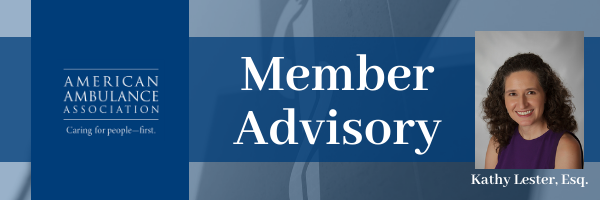By: Tristan North and Kathy Lester, JD, MPH
This is the second part of a two part Member Advisory by Tristan North and Kathy Lester on ACA Repeal & Reform. Read Part One: ACA Repeal & Reform – What It Means for Ambulance Services (Pt. 1).
The remainder of this alert provides more detail about the House legislation, as well as key bills that have been introduced in the Senate. It also provides background on the process to date.
While three House Committees have referred the ACHA to the full House, over the weekend it became clear that there Speaker Paul Ryan (R-WI) will entertain amendments to the current text. As these agreements become available, we will provide an updated analysis.
The AHCA seeks to redefine the ACA in significant ways. First, it would repeal the penalties related to the individual and employer mandates. It would allow insurance companies to apply a 30 percent late-enrollment surcharge on individual and small group market applicants who have not had coverage in the previous 63 days. It would phase out the Medicaid expansion program, shifting it to a per capita cap model. It would also eliminate many of the taxes implemented under the ACA. It would delay implementation of the “Cadillac Tax” on high cost health plans until 2025. It would repeal the cost sharing subsidies program.
The AHCA would retain certain popular ACA provisions, including allowing children to stay on their parents’ insurance until age 26 and requiring insurers to cover people with pre-existing conditions.
Some additional highlights of the plan include:
- Establishing a temporary Patient and State Stability Fund to “lower patient costs and stabilize State markets.” Dollars from the fund could be used to:
- Provide assistance to high-risk individuals who do not have access to health insurance coverage offered through an employer.
- Provide incentives to appropriate entities to enter into arrangements with the State to help stabilize premiums.
- Reduce the cost of providing health insurance coverage in the individual and small group market for otherwise high-cost individuals.
- Promote participation in the individual and small group markets in the State and increasing available health insurance options.
- Promote access to preventive services, dental care services, and mental health and substance use disorder services.
- Provide payments, directly or indirectly, to health care providers for the provision of certain health care services.
- Provide assistance to reduce consumer out-of-pocket costs for individuals enrolled in health insurance coverage in the State.
- Eliminates presumptive eligibility determinations for Medicaid.
- Decreases mandatory Medicaid income eligibility level from 133 percent of the federal poverty level (FPL) to 100 percent, effective Dec. 31, 2019.
- Provides $10 billion total over five years for FMAP payments to non-expansion States that adjust the payment amounts otherwise provided to health care providers for services furnished to Medicaid enrollees.
- Increases the basic limit on aggregate health savings account (HSA) contributions to equal the maximum limit on the amount of the annual deductible and out-of-pocket expenses of a high deductible health plan beginning in 2018.
- Repeals current actuarial value standards related to the ACA metal levels of coverage, effective for plan years 2020 and beyond.
- Eliminates the Disproportionate Share Hospital (DSH) payment cuts.
- Repeals Prevention and Public Health Fund funding for FY 2019 and beyond.
- Provides $422 million in funding for FY 2017 for the Community Health Center Fund, which makes grants to Federally-Qualified Health Centers (FQHCs).
The Congressional Budget Office (CBO) estimates that the AHCA will reduce the deficit by $337 billion. CBO predicts that by 2018, 14 million more people would join the ranks of the uninsured under the AHCA. This number would reach the 24 million by 2026, when “an estimated 52 million people would be uninsured, compared with 28 million who would lack insurance that year under current law.” CBO also predicts that while there would be an initial 15 to 20 percent increase in premiums in 2018, average premium amounts would drop to 10 percent compared to current law. CBO indicates that Medicaid expenditures would fall by $880 billion over 10 years and 14 million fewer Americans would be enrolled in Medicaid by 2026.
The American Medical Association (AMA), AARP, the American Hospital Association (AHA), the Federation of American Hospitals, the Association of American Medical Colleges, the American Nurses Association, the American College of Physicians oppose the AHCA. Other organizations have expressed serious concern, including the American Health Care Association (nursing homes) and the American Academy of Family Physicians. America’s Health Insurance Plans (AHIP) has expressed concerns, but is open to compromise.
Senate ACA Reform Legislation
It is more difficult to anticipate how the Senate will react to the House legislation. However, it is likely that Senate Republicans will support at least some of the following reform ideas:
- HSAs could be paired with health insurance plans that have high deductibles and low premiums. Republicans favor HSAs because they generally shift a greater amount of financial responsibility to the beneficiary. HSA could be designed to include tax-free contributions, growth of savings, and medical expense withdrawals.
- High-risk pools. While policies to address the problem of the risk pools could take many forms, there have been focused efforts to remove individuals with pre-existing conditions from the general pool of health insurance to lower the premiums for the young and healthy. Some States have attempted to implement high-risk pools in the past; however, previous iterations have been expensive.
- Medicaid reform. Republicans remain concerned about the expense of the Medicaid program and have suggested per-capita grants, which would allocate a set amount of money per enrollee in the state.
- Tax credits for health insurance. Republicans prefers to use tax credits to help people buy insurance rather than keep the ACA’s subsidies. Several proposals have been discussed, including age-adjusted credits or credits based on number of family members.
While there may be an effort to amend the House’s AHCA, there is at least one Senate bill that has earned some attention. Sens. Bill Cassidy (R-LA) and Susan Collins (R-ME) introduced “The Patient Freedom Act” earlier this year. It would replace the current Exchange structure and allow States to select from one of three alternatives for providing coverage to its citizens.
First, States could re-implement the ACA coverage they have been relying upon, if the think it is working for them. States could continue to receive federal premium tax credits, cost-sharing subsidies, and Medicaid dollars, to the extent that such subsidies do not exceed a certain limit. Second, States could enact a new market-based system that would retain popular ACA provisions, such as protecting those with pre-existing conditions. They could continue to receive funding equal to 95 percent of federal premium tax credits and cost-sharing subsidies, as well as the federal match for Medicaid expansion. States could choose to receive funds in the form of per beneficiary grants or advanced refundable tax credits, but in both cases, funds would be deposited in a Roth Health Savings Account (HSA), meaning the money would go directly to the patient. Third, States could decide not to take any federal assistance and design and oversee the insurance market without federal intervention.
This legislation also seeks to curb high costs medical expenses and includes a broad provision seeks to ensuring access to emergency services without excessive charges for out-of-network services. AAA and our members are working to explain the unique nature of ambulance services to avoid this provision inappropriately being applied to ground ambulance services.
It is likely that other proposals will arise in the Senate and that the Senate Finance Committee will develop a proposal that could amend the AHCA or take a different path. We will provide you with more information as the proposals develop.
Process for Repeal and Reform
Republicans intend to address repeal and replace through three actions. First, the Congress passed the 2017 Budget Reconciliation legislation to repeal key structural pieces of the ACA. The second set of actions are being undertaken by the Trump Administration, which is making changes to the ACA through the administrative or regulatory process. Third, congressional Republicans are now in the process of moving a second piece of legislation later in the year that would address the specifics of the replace.
With passage of the FY2017 Budget Resolution (S.Con.Res. 3), Congressional Republicans took the first step to repealing the ACA. On January 12, the Senate voted 51 to 48 in favor of a FY2017 Budget, which included the budget framework for repealing the ACA. The House followed suit on January 13 by a vote of 227 to 198. While not binding or needing the signature of the President, the passage of the FY2017 Budget provides authority to the House and Senate committees of jurisdiction to move forward on the provisions of a FY2017 Budget Reconciliation package. The Reconciliation package is binding and would be sent to President Trump for his signature. This would actually repeal the ACA.
Congressional Republicans are using the budget reconciliation process, as it only requires a simple majority in the Senate to pass. Senate Democrats can therefore not filibuster the package unlike most legislation that requires 60 votes to end debate. This is the same process Democrats used back in 2010 to pass portions of the ACA.
During the week of March 6, the House Energy & Commerce and Ways & Means Committee passed their respective sections of repeal in replace as part of the FY2017 Budget Reconciliation package which has been named the American Health Care Act (AHCA). On March 16, the House Budget Committee combined the sections and approved the package. The House Rules Committee is expected to meet on the rules debate by Wednesday with the full House expected to consider the bill on March 23. Passage of the bill is likely but not certain as some more conservative as well as more moderate members of the Republican Caucus are expected to join with possibly all Democrats in opposition to the bill. Several more moderate as well as conservative Republican Senators have also voiced concerns leaving in doubt whether the bill can pass the Senate.
Repealing the ACA is actually much easier than passing a second piece of legislation later to address the specifics of the replacement. Much of the ACA replacement package is subject to a point of order and can’t be included in a Budget Reconciliation bill because such a package can only be used for provisions that increase or reduce the budget. So Republicans will need the support of eight Senate Democrats to pass a second replacement package. All this will ensure a very intense next few months or longer as repeal and replacement moves forward.
Administrative Actions
As noted, another critical piece of the three-step process of repealing and replacing/refining the ACA comes from the Trump Administration. One of President Trump’s first actions after being sworn in as the 45th President of the United States was to issue an Executive Order to federal agencies to “waive, defer, grant exemptions from, or delay the implementation of any provision or requirement [of the Affordable Care Act]…that would impose a fiscal burden on any State, or a cost, fee, tax, penalty, or regulatory burden on an individual.” The Executive Order also directs agencies to provide relief to the states, as well as “waive” regulations or costs on “makers of medical devices, products, or medications.”
Although the Executive Order does not legally halt any of the policies from continuing in its current state, such as the individual mandate or the medical device excise tax, it does give a clear signal from the new Trump Administration on its intent to dismantle the ACA quickly, without waiting for Congress. The Order does confirm that the new Administration will follow the Administrative Procedure Act, which requires federal agencies to go through a formal rulemaking process to implement major changes.
Soon after, the Administration released one of its first proposed rules, entitled “Marketplace Stabilization.” Overall, the rule proposes a series of modifications to the Marketplaces that align with requests made by issuers in an attempt to keep them in the Marketplaces. (Please see the March 1, 2017, Member Advisory for more details about this proposed rule)
More recently, Secretary of the Department of Health and Human Services (HHS) Tom Price and Centers for Medicare and Medicaid Services (CMS) Seema Verma sent a letter to State Governors describing their plans for the Medicaid Program (Please see the March 17 Member Advisory for more details about this letter).
There are several other ways that the Secretary and Administrator can dismantle the ACA without Congressional intervention. These include:
- Stopping enforcing the individual mandate. In coordination with Treasury Department, the Secretary could limit or stop the collection of the penalty for those without health insurance.
- Modifying hardship waivers. The Secretary has significant discretion in defining what constitutes “hardship” when granting exemption to the individual mandate penalty and could expand this definition to grant more exemptions.
- Limiting or eliminating women’s preventive services. The Secretary could expand the Hobby Lobby exemption available to religious organizations, nonprofits, and closely-held for-profit corporations; exclude contraception from the list of women’s preventive services; or entirely eliminate coverage of women’s preventive services.
- Narrowing regulations on EHBs. The ACA establishes 10 EHB categories, but the Secretary has the authority to issue regulations that would permit insurers to more narrowly define what it means to cover the categories. Similarly, the Secretary could adjust revise or eliminate the requirements related to defining EHBs by referencing benchmark plans.
- Restricting special enrollment periods. The Secretary could establish additional requirements for those trying to sign up outside of the open enrollment period, such as requiring more documentation.
- Approving different 1115 waivers for Medicaid. As evidenced in the recent letter to State Governors, the Secretary and Administrator have already signaled that they are likely to approve different Medicaid waivers than were provided during the Obama Administration.
We will keep you posted of new developments on repeal and replace of the Affordable Care Act.










